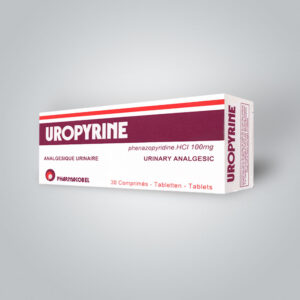 UROPYRINE 100mq coated tablets
UROPYRINE 100mq coated tablets
UROPYRINE
International non-patented name: Phenazopyridine hydrochloride
Composition
Active substance: 1 tablet contains 100 mg of phenazopyridine hydrochloride.
Excipients: corn starch, talc, calcium carbonate, purified water.
Description
Brown, oval-shaped coated tablets.
Pharmacological properties
Pharmacodynamics
Phenazopyridine hydrochloride is a non-narcotic analgesic. By non-selective inhibition of cyclooxygenase, it relieves symptoms such as pain, burning, and swelling by having a local analgesic effect on the mucous membrane of the urinary tract during inflammatory diseases of the bladder and ureters, traumatic injuries. Prevents frequent urination due to urinary tract infection.
Pharmacokinetics
Phenazopyridine hydrochloride is absorbed from the gastrointestinal tract, more than 90% of which is absorbed from 12 mg. The combination with blood proteins is 20%. It is mainly excreted in the urine, 65% of which is unchanged, 18% comes out in the form of paracetamol, and the rest is transformed into inactive metabolites. After 6 hours, the drug is completely excreted from the body through the kidneys.
Indication for use
Infection of the mucous membrane of the lower urinary tract (cystitis, urethritis). In addition to litholytic preparations (in order to eliminate the feeling of pain caused by stones falling into the canal).
Post-surgical period. During endoscopic examinations. Pain during bladder catheterization and traumatic injury. Burning and burning sensation. In order to relieve symptoms such as frequent urination. Phenazopyridine hydrochloride can be used without determining the diagnosis and investigating the cause of the disease. It is only necessary to take into account that Phenazopyridine hydrochloride symptomatically eliminates the symptoms of the disease and its use can be stopped after the etiotropic treatment of the disease is started.
Against the background of Uropirin tablets, the need for the use of systemic analgesics and narcotic analgesics decreases. In the case of urinary tract infection, it is used for no more than 2-3 days as a symptomatic therapy before antibacterial therapy.
Contraindications
Hypersensitivity to phenazopyridine hydrochloride and other components of the drug.
Qlükoza-6-fosfodehidrogenaza fermentinin çatışmazlığı.
Orta və ağır dərəcəli böyrək pozğunluqları, qlomerulonefrit.
Qaraciyər pozğunluqları, kəskin hepatit. Anemiya, methemoqlobinemiya.
Interaction with other medicines
It can change the results of some laboratory tests. When undergoing any laboratory tests, inform the laboratory doctor that you are taking uropirin tablets.
Use during pregnancy and lactation
Fertility and fetotoxic properties were not detected in the reproductive studies conducted on laboratory animals – in rats at a dose of 50 mg/kg/day. Since no studies of the same name were conducted in pregnant women, the use of the drug during pregnancy should be strictly justified.
There is no information on the transfer of phenazopyridine hydrochloride to breast milk.
Method of use and dosage
Children 6-12 years old The daily dose is 12 mg/kg of body weight. In this age category, the maximum duration of treatment is 2 days.
Adults and children over 12 years of age Usual dose – 2 tablets of 100 mg taken 3 times a day. When used together with antibiotics, the duration of use cannot exceed 2 days. If Uropirin is prescribed alone, the duration of use can be as short as possible – a maximum of 7-10 days.
Tablets are taken inside with 1 glass of water without chewing and after a meal.
Side effects
Stomach discomfort, headache, dizziness may be observed. Inform your doctor about these or other cases. The drug dyes the color of urine red, but this is harmless. This condition disappears after stopping the use of the drug. In case of an allergic reaction – rash, itching, difficulty breathing, etc., it is necessary to stop using the drug and inform the doctor.
Overdose
Exceeding the recommended dose may increase the plasma level of the drug in the blood. Methemoglobinemia is observed in very high doses and during acute poisoning. At this time, 102 mg/kg body weight of Methylene chloride is administered intravenously or 100-200 mg of Ascorbic acid is administered intravenously, which reduces the level of methemoglobin in the blood and eliminates cyanosis. Oxidative Heinz hemolytic anemia is observed during chronic poisoning. It can cause hemolysis in individuals with glucose-6-phosphodehydrogenase deficiency. Sometimes it can cause liver and kidney disorders.
Packing form
10 tablets in a blister covered with aluminum foil. 3 blisters (30 tablets) are packed in a cardboard box together with a leaflet.
Store condition
t should be stored at a temperature below 25-30 °C, in a dry, dark place and out of the reach of children.
Shelf life
5 years.
By prescription
Manufacturer
S.A.Laboratories STEROP. Laboratoria N.V.Belgium.
